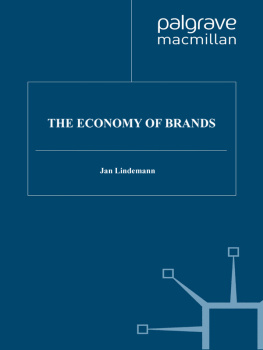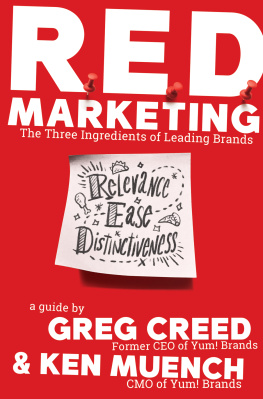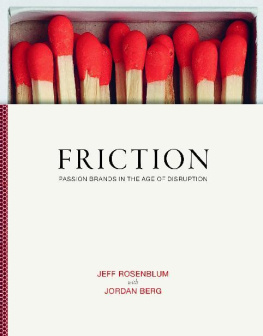Jan Lindemann - The Economy of Brands
Here you can read online Jan Lindemann - The Economy of Brands full text of the book (entire story) in english for free. Download pdf and epub, get meaning, cover and reviews about this ebook. year: 2010, publisher: Palgrave Macmillan, genre: Business. Description of the work, (preface) as well as reviews are available. Best literature library LitArk.com created for fans of good reading and offers a wide selection of genres:
Romance novel
Science fiction
Adventure
Detective
Science
History
Home and family
Prose
Art
Politics
Computer
Non-fiction
Religion
Business
Children
Humor
Choose a favorite category and find really read worthwhile books. Enjoy immersion in the world of imagination, feel the emotions of the characters or learn something new for yourself, make an fascinating discovery.
- Book:The Economy of Brands
- Author:
- Publisher:Palgrave Macmillan
- Genre:
- Year:2010
- Rating:5 / 5
- Favourites:Add to favourites
- Your mark:
- 100
- 1
- 2
- 3
- 4
- 5
The Economy of Brands: summary, description and annotation
We offer to read an annotation, description, summary or preface (depends on what the author of the book "The Economy of Brands" wrote himself). If you haven't found the necessary information about the book — write in the comments, we will try to find it.
The Economy of Brands — read online for free the complete book (whole text) full work
Below is the text of the book, divided by pages. System saving the place of the last page read, allows you to conveniently read the book "The Economy of Brands" online for free, without having to search again every time where you left off. Put a bookmark, and you can go to the page where you finished reading at any time.
Font size:
Interval:
Bookmark:
The Economy of Brands
Jan Lindemann


Jan Lindemann 2010
All rights reserved. No reproduction, copy or transmission of this
publication may be made without written permission.
No portion of this publication may be reproduced, copied or transmitted
save with written permission or in accordance with the provisions of the
Copyright, Designs and Patents Act 1988, or under the terms of any licence
permitting limited copying issued by the Copyright Licensing Agency,
Saffron House, 610 Kirby Street, London EC1N 8TS.
Any person who does any unauthorized act in relation to this publication
may be liable to criminal prosecution and civil claims for damages.
The author has asserted his right to be identified as the author of this
work in accordance with the Copyright, Designs and Patents Act 1988.
First published 2010 by
PALGRAVE MACMILLAN
Palgrave Macmillan in the UK is an imprint of Macmillan Publishers Limited,
registered in England, company number 785998, of Houndmills, Basingstoke,
Hampshire RG21 6XS.
Palgrave Macmillan in the US is a division of St Martins Press LLC,
175 Fifth Avenue, New York, NY 10010.
Palgrave Macmillan is the global academic imprint of the above companies
and has companies and representatives throughout the world.
Palgrave and Macmillan are registered trademarks in the United States,
the United Kingdom, Europe and other countries.
ISBN 9780230232501
This book is printed on paper suitable for recycling and made from fully
managed and sustained forest sources. Logging, pulping and manufacturing
processes are expected to conform to the environmental regulations
of the country of origin.
A catalogue record for this book is available from the British Library.
A catalog record for this book is available from the Library of Congress.
10 9 8 7 6 5 4 3 2 1
19 18 17 16 15 14 13 12 11 10
Printed and bound in Great Britain by
CPI Antony Rowe, Chippenham and Eastbourne
Tables
Figures
ABS | asset-backed security |
BAV | brand asset valuator |
B2B | business to business |
B2C | business to consumer |
BC | brand contribution |
BCL | brand contribution of the licensee |
BE | brand earnings |
BI | brand impact |
BLR | brand license revenue |
BR | brand royalty |
CAPM | capital asset pricing model |
CEO | chief executive officer |
CFO | chief finance officer |
CMO | chief marketing officer |
CSR | corporate social responsibility |
DCF | discounted cash flow |
EBIT | earnings before interest and tax |
EBITDA | earnings before interest, tax, depreciation, and amortization |
EPS | earnings per share |
FAS | Federal Accounting Standard |
FRS | Financial Reporting Standard |
GDP | gross domestic product |
HR | human resources |
IAS | International Accounting Standard |
IE | intangible earnings |
IFRS | International Financial Reporting Standard |
IP | intellectual property |
ISVC | International Standards Valuation Committee |
KPI | key performance indicator |
M&A | mergers and acquisitions |
NPV | net present value |
PPA | purchase price allocation |
PR | public relations |
R&D | research and development |
ROE | return on equity |
ROI | return on investment |
SEM | structural equation modeling |
SPV | special purpose vehicle |
WACC | weighted average cost of capital |
The past 25 years have seen the recognition of intangible assets as the main drivers of business and shareholder value. In many businesses brands now account for the majority of shareholder value. This is not only true for the classic consumer goods businesses such as The Coca-Cola Company or Unilever but also for many B2B businesses selling to a professional audience. It is therefore important to understand how the economy of brands works and how it can be exploited to create sustainable value. The purpose of this book is to develop and enhance the understanding of the brand as an economic asset in order to make better business and investment decisions. It looks at the value creation of the brand from all aspects and provides approaches on how to assess and manage the value of brands. The book is written from a practitioners perspective and is based on the authors experience in the practical application of brand value in all relevant areas.
Different chapters will consider the economic value of brands from a theoretical and practical point of view. The first chapter deals with the variety of definitions of brands and provides the economic definition of the brand adopted in this book.. In the final chapter a brand management framework is discussed and developed. The findings and insights of the book are summed up in the Conclusion.
Understanding and measuring the economic value creation of brands requires a clear understanding and definition of what a brand is. The word brand is derived from the old Norse word brenna which means to burn. By burning signs onto cattle skin farmers could demonstrate their ownership. Although the initial purpose of branding was to demonstrate the origin of an animal it quickly grew into a means of differentiation. Over time a farmer would establish a certain reputation for the quality of his cattle expressed by the branded mark on the animal. This enabled buyers to quickly assess the quality of the cattle and the price they were willing to pay for it. The information provided by the brand helped to guide the purchase decision. Facilitating choice is probably the most important purpose of branding in commerce. Understanding how the brand guides customer choice is crucial in defining what a brand is and what economic value it creates.
Brands can be traced back to ancient civilizations as evidenced by archeological proofs from Etruria, Greece, and Rome. Producers marked their pottery to communicate their origin and quality.of differentiating their goods. It was during this period that brands such as Campbells, Coca-Cola, and Quaker Oats emerged. In the US market these goods are still called packaged goods.
In the late 1880s, James Walter Thompson, founder of the advertising company JWT and one of the pioneers of brand advertising, published so-called house advertisements to explain and sell the services of his agency to potential clients. Thompson drew on insights derived from behavioral psychology and advanced market research. His house advertisements were amongst the first systematic descriptions of the use and effect of brand advertising and an early commercial explanation of what is today defined as branding. Consumer goods companies started developing sophisticated communications strategies including brand positioning, tag lines for advertising campaigns, packaging design, mascots, and jingles to build their brands through media communications mainly radio and television. By the 1940s, consumer marketing became more sophisticated as companies began to understand and recognize the social, psychological, and anthropological dimensions of the relationship consumers were developing with their brands. Increasingly brand communications expanded beyond promising quality towards building more complex psychological associations. As the quality of many products became increasingly similar and difficult to differentiate brands had to offer additional, mainly emotional benefits to be distinguishable. Most of these emotional benefits provide means of self-expression and definition. Buying and owning a specific brand communicates specific associations and values internally as well as externally. For example a buyer of a pair of Nike sport shoes communicates to both the outside world and the owner of the brand success, performance, and winning. Both internal and external communications are closely linked with the internal feeding on the external. Alongside the emotional benefits there are also perceptions about tangible or material brand benefits. In most categories consumers can choose from a wide range of options however, they can no longer test and compare the actual material differences of these offers. Some material benefits such as quality are also hard to define as they comprise different aspects such as durability, functionality, timeless design, etc. Often, therefore, consumers have to rely on the brand communications not only for intangible but also tangible benefits.
Next pageFont size:
Interval:
Bookmark:
Similar books «The Economy of Brands»
Look at similar books to The Economy of Brands. We have selected literature similar in name and meaning in the hope of providing readers with more options to find new, interesting, not yet read works.
Discussion, reviews of the book The Economy of Brands and just readers' own opinions. Leave your comments, write what you think about the work, its meaning or the main characters. Specify what exactly you liked and what you didn't like, and why you think so.










